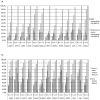Reliability of Assessing Hand Osteoarthritis on Digital Photographs and Associations With Radiographic and Clinical Findings
- PMID: 26259552
- PMCID: PMC4153954
- DOI: 10.1002/acr.22225
Reliability of Assessing Hand Osteoarthritis on Digital Photographs and Associations With Radiographic and Clinical Findings
Abstract
Objective: To investigate the reliability and construct validity of an atlas for grading hand osteoarthritis (OA) on photographs in a separate younger community-dwelling population than the development cohort.
Methods: Participants were community-dwelling adults (ages ≥50 years) in North Staffordshire, UK with hand pain or hand problems in the last year who attended a research clinic. High-quality photographs were taken in a standardized position. A photographic atlas was used to score hand joints (second and third distal interphalangeal [DIP], second and third proximal interphalangeal [PIP], and first carpometacarpal [CMC] joints) and joint groups (DIP, PIP, and CMC joints) for OA on a 0-3 scale. Hand radiographs were graded for OA using the Kellgren/Lawrence (K/L) grading system. Clinical features (nodes, bony enlargement, and deformity) were determined by physical examination. Associations of photographic hand OA grades with radiographic OA and clinical features were determined to assess construct validity.
Results: In total, 558 participants (mean age 64 years, 62% women) were included in the analyses. Reliability for scoring OA on the photographs was good (mean intrarater intraclass correlation coefficient [ICC] 0.77 and mean interrater ICC 0.71). At the joint level, photographic hand OA grade was positively associated with radiographic OA grade (Spearman's ρ = 0.19-0.57, P < 0.001) and the number of clinical features (Spearman's ρ = 0.36-0.59, P < 0.001). At the person level, individuals with higher global photographic OA scores had higher summed K/L scores and higher percentages meeting the American College of Rheumatology clinical hand OA criteria.
Conclusion: This photographic scoring system was reliable and a good indicator of hand OA in a separate younger community-dwelling population than the development cohort. This method of data collection offers researchers a feasible alternative to physical examination and radiography.
© 2014 The Authors. Arthritis Care & Research is published by Wiley Periodicals, Inc. on behalf of the American College of Rheumatology.
Figures



Similar articles
-
Longitudinal validity of using digital hand photographs for assessing hand osteoarthritis progression over 7 years in community-dwelling older adults with hand pain.BMC Musculoskelet Disord. 2019 Oct 27;20(1):484. doi: 10.1186/s12891-019-2829-0. BMC Musculoskelet Disord. 2019. PMID: 31656178 Free PMC article.
-
Age related prevalence of hand osteoarthritis diagnosed by photography (HOASCORE).BMC Musculoskelet Disord. 2017 Dec 2;18(1):508. doi: 10.1186/s12891-017-1870-0. BMC Musculoskelet Disord. 2017. PMID: 29197369 Free PMC article.
-
Utility of digital photographs of the hand for assessing the presence of hand osteoarthritis.Osteoarthritis Cartilage. 2004 May;12(5):360-5. doi: 10.1016/j.joca.2004.01.003. Osteoarthritis Cartilage. 2004. PMID: 15094134
-
[Hand osteoarthritis].Cas Lek Cesk. 2016 Fall;155(6):305-309. Cas Lek Cesk. 2016. PMID: 27917634 Review. Czech.
-
Validation of HAND OA US inflammatory and structural damage score (HOUSE) for thumb-base joints: systematic review on truth and discrimination.Rheumatology (Oxford). 2025 Mar 1;64(3):919-934. doi: 10.1093/rheumatology/keae417. Rheumatology (Oxford). 2025. PMID: 39115887
Cited by
-
Patterns and natural history of hand pain in individuals with symptomatic hand osteoarthritis in a prospective cohort study: A post-hoc analysis of a randomised controlled trial.Osteoarthr Cartil Open. 2023 Oct 20;5(4):100413. doi: 10.1016/j.ocarto.2023.100413. eCollection 2023 Dec. Osteoarthr Cartil Open. 2023. PMID: 37920673 Free PMC article.
-
"How would you handle this?" The impact of embedding early patient and public involvement in a biomechanical computational engineering doctoral research project.Res Involv Engagem. 2025 Mar 18;11(1):26. doi: 10.1186/s40900-025-00694-3. Res Involv Engagem. 2025. PMID: 40102991 Free PMC article.
-
Hand and knee osteoarthritis are associated with reduced diameters in retinal vessels: the AGES-Reykjavik study.Rheumatol Int. 2019 Apr;39(4):669-677. doi: 10.1007/s00296-019-04243-6. Epub 2019 Jan 22. Rheumatol Int. 2019. PMID: 30671597 Free PMC article.
-
Longitudinal validity of using digital hand photographs for assessing hand osteoarthritis progression over 7 years in community-dwelling older adults with hand pain.BMC Musculoskelet Disord. 2019 Oct 27;20(1):484. doi: 10.1186/s12891-019-2829-0. BMC Musculoskelet Disord. 2019. PMID: 31656178 Free PMC article.
-
Age related prevalence of hand osteoarthritis diagnosed by photography (HOASCORE).BMC Musculoskelet Disord. 2017 Dec 2;18(1):508. doi: 10.1186/s12891-017-1870-0. BMC Musculoskelet Disord. 2017. PMID: 29197369 Free PMC article.
References
-
- Wilder FV, Barrett JP, Farina EJ. Joint-specific prevalence of osteoarthritis of the hand. Osteoarthritis Cartilage. 2006;14:953–7. - PubMed
-
- Dziedzic K, Thomas E, Hill S, Wilkie R, Peat G, Croft PR. The impact of musculoskeletal hand problems in older adults: findings from the North Staffordshire Osteoarthritis Project (NorStOP) Rheumatology (Oxford) 2007;46:963–7. - PubMed
-
- Hart DJ, Spector TD. Definition and epidemiology of osteoarthritis of the hand: a review. Osteoarthritis Cartilage. 2000;8:S2–7. - PubMed
-
- Salaffi F, Carotti M, Stancati A, Grassi W. Radiographic assessment of osteoarthritis: analysis of disease progression. Aging Clin Exp Res. 2003;15:391–404. - PubMed
Publication types
MeSH terms
Grants and funding
LinkOut - more resources
Full Text Sources
Other Literature Sources
Medical

